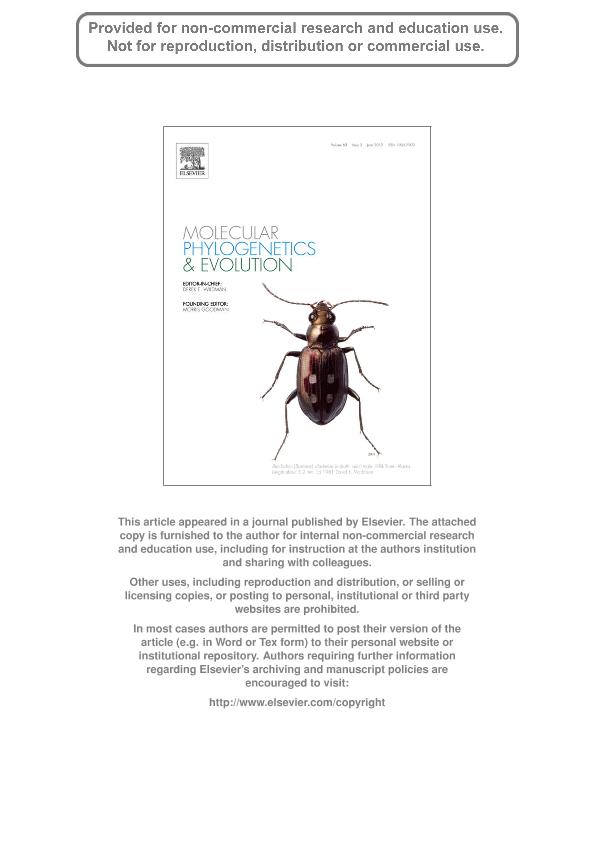Mostrar el registro sencillo del ítem
dc.contributor.author
Sato, Jun J.
dc.contributor.author
Wolsan, Mieczyslaw
dc.contributor.author
Prevosti, Francisco Juan

dc.contributor.author
D'Elía, Guillermo
dc.contributor.author
Begg, Colleen
dc.contributor.author
Begg, Keith
dc.contributor.author
Hosoda, Tetsuji
dc.contributor.author
Campbell, Kevin L.
dc.contributor.author
Suzuki, Hitoshi
dc.date.available
2019-01-09T20:04:43Z
dc.date.issued
2012-06
dc.identifier.citation
Sato, Jun J.; Wolsan, Mieczyslaw; Prevosti, Francisco Juan; D'Elía, Guillermo; Begg, Colleen; et al.; Evolutionary and biogeographic history of weasel-like carnivorans (Musteloidea); Academic Press Inc Elsevier Science; Molecular Phylogenetics and Evolution; 63; 3; 6-2012; 745-757
dc.identifier.issn
1055-7903
dc.identifier.uri
http://hdl.handle.net/11336/67833
dc.description.abstract
We analyzed a concatenated (8492. bp) nuclear-mitochondrial DNA data set from 44 musteloids (including the first genetic data for Lyncodon patagonicus) with parsimony, maximum likelihood, and Bayesian methods of phylogenetic and biogeographic inference and two Bayesian methods of chronological inference. Here we show that Musteloidea emerged approximately 32.4-30.9 million years ago (MYA) in Asia, shortly after the greenhouse-icehouse global climate shift at the Eocene-Oligocene transition. During their Oligocene radiation, which proceeded wholly or mostly in Asia, musteloids diversified into four primary divisions: the Mephitidae lineage separated first, succeeded by Ailuridae and the divergence of the Procyonidae and Mustelidae lineages. Mustelidae arose approximately 16.1 MYA within the Mid-Miocene Climatic Optimum, and extensively diversified in the Miocene, mostly in Asia. The early offshoots of this radiation largely evolved into badger and marten ecological niches (Taxidiinae, Melinae, Mellivorinae, Guloninae, and Helictidinae), whereas the later divergences have adapted to other niches including those of weasels, polecats, minks, and otters (Mustelinae, Ictonychinae, and Lutrinae). Notably, and contrary to traditional beliefs, the morphological adaptations of badgers, martens, weasels, polecats, and minks each evolved independently more than once within Mustelidae. Ictonychinae (which is most closely related to Lutrinae) arose approximately 9.5-8.9 MYA, most likely in Asia, where it diverged into the Old World Ictonychini (Vormela, Poecilictis, Ictonyx, and Poecilogale) and New World Lyncodontini (Lyncodon and Galictis) lineages. Ictonychini presumably entered Africa during the Messinian Salinity Crisis (at the Miocene-Pliocene transition), which interposed the origins of this clade (approximately 6.5-6.0 MYA) and its African Poecilictis- Ictonyx- Poecilogale subclade (approximately 4.8-4.5 MYA). Lyncodontini originated approximately 2.9-2.6 MYA at the Pliocene-Pleistocene transition in South America, slightly after the emergence of the Panamanian land bridge that provided for the Great American Biotic Interchange. As the genera Martes and Ictonyx (as currently circumscribed) are paraphyletic with respect to the genera Gulo and Poecilogale, respectively, we propose that Pekaniaand Poecilictis be treated as valid genera and that Martes pennanti and Ictonyx libyca, respectively, be assigned to these genera.
dc.format
application/pdf
dc.language.iso
eng
dc.publisher
Academic Press Inc Elsevier Science

dc.rights
info:eu-repo/semantics/openAccess
dc.rights.uri
https://creativecommons.org/licenses/by-nc-nd/2.5/ar/
dc.subject
Biogeography
dc.subject
Carnivora
dc.subject
Divergence Times
dc.subject
Evolution
dc.subject
Mustelidae
dc.subject
Phylogeny
dc.subject.classification
Otras Ciencias Biológicas

dc.subject.classification
Ciencias Biológicas

dc.subject.classification
CIENCIAS NATURALES Y EXACTAS

dc.title
Evolutionary and biogeographic history of weasel-like carnivorans (Musteloidea)
dc.type
info:eu-repo/semantics/article
dc.type
info:ar-repo/semantics/artículo
dc.type
info:eu-repo/semantics/publishedVersion
dc.date.updated
2019-01-09T17:48:16Z
dc.journal.volume
63
dc.journal.number
3
dc.journal.pagination
745-757
dc.journal.pais
Estados Unidos

dc.description.fil
Fil: Sato, Jun J.. Fukuyama University; Japón
dc.description.fil
Fil: Wolsan, Mieczyslaw. Polish Academy of Sciences; Argentina
dc.description.fil
Fil: Prevosti, Francisco Juan. Consejo Nacional de Investigaciones Científicas y Técnicas. Oficina de Coordinación Administrativa Parque Centenario. Museo Argentino de Ciencias Naturales “Bernardino Rivadavia”; Argentina
dc.description.fil
Fil: D'Elía, Guillermo. Universidad Austral de Chile; Chile
dc.description.fil
Fil: Begg, Colleen. No especifica;
dc.description.fil
Fil: Begg, Keith. No especifica;
dc.description.fil
Fil: Hosoda, Tetsuji. Taikyu High School; Japón
dc.description.fil
Fil: Campbell, Kevin L.. University of Manitoba; Canadá
dc.description.fil
Fil: Suzuki, Hitoshi. Hokkaido University; Argentina
dc.journal.title
Molecular Phylogenetics and Evolution

dc.relation.alternativeid
info:eu-repo/semantics/altIdentifier/doi/http://dx.doi.org/10.1016/j.ympev.2012.02.025
dc.relation.alternativeid
info:eu-repo/semantics/altIdentifier/url/https://www.sciencedirect.com/science/article/pii/S1055790312000784
Archivos asociados
